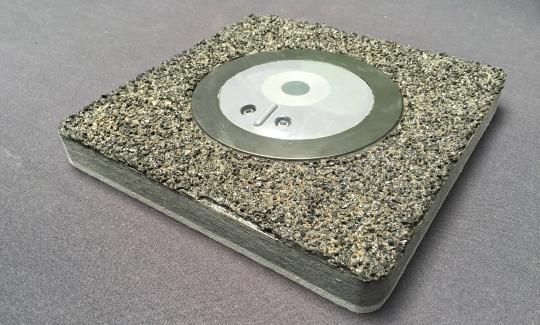Smartphone navigation? Solved. Modern apps will even route you around traffic, automatically picking the most efficient way to get where you’re going.

That’s the VoicePark sensor embedded in a sample slab of street pavement. (Photo: Rafe Needleman/Yahoo)
What we don’t have yet is an app that will reliably tell us where to park once we get where we’re going. One startup in the “Internet of Things for Cities” exhibits (co-located with the Wearable World Congress show in San Francisco this week) is trying to solve this issue:VoicePark.
VoicePark wants to install parking-space sensors in every potential on-street spot in a city. The combined visible-light and infra-red sensors are, I was told, extremely accurate at determining if a car is overhead. They’re supposed to be far more reliable than magnetic sensors. They communicate wirelessly, presumably over a lower-power mesh network, and run on batteries that are supposed to last four years or more.
Combine a city full of VoicePark sensors with a navigation app that knows where you’re going (because you tell it), and the idea is that as you approach your destination, it will tell you, with perfect accuracy, where there is an open spot — even if it’s a block or two before your destination.
If there isn’t an open spot, the data from the VoicePark sensor network provides enough information for the system to know how long cars have been parked and how the flow of parking-space usage works in an area, so that it can more accurately predict where you can head for the best chance of nabbing a spot from somebody who’s leaving.
This is a hugely ambitious project. Getting a city to adopt an infrastructure play like this, one that requires installing hundreds of thousands of devices in city streets — and then replacing each one’s batteries every four to five years — is not an undertaking for the weak or impatient.
The difficulty isn’t just getting cities to try out, approve, and then fund an installation that doesn’t generate revenue. There’s also a high level of technological risk for this idea: It’s quite possible that within a few years, we won’t need dedicated sensors to read parking spaces. No, I don’t know what will replace them. Maybe cars themselves will report on open spots; maybe utility-pole-mounted cameras will. Maybe drones. Maybe the car of the future won’t need to park near your destination at all: It will just drop you at the door and then skulk off to park itself at a remote location until you’re ready to be picked up. In other words, I wouldn’t bet on street-embedded sensors being needed forever to perform this function.
But for the time being, drivers need this, and cities do, too. An immense amount of gasoline is wasted by people orbiting for spots, and these people lose time and cause traffic congestion and pollution.
Currently, VoicePark is running a few trials. One is on a tiny number of spots at the Palace of Fine Arts in San Francisco (where the Wearable World Congress event is taking place). I hope it eventually works. I tried the app that’s supposed to show me which of the 30 monitored spots are free, but I couldn’t get it to function.
I could have used a working parking-spot finder this morning; instead I had to circle this residential neighborhood looking for a spot before I gave up and parked at a lot several blocks away. The walk was good for my health, but as I said, driving in circles has never been an efficient use of workday time.
No comments:
Post a Comment